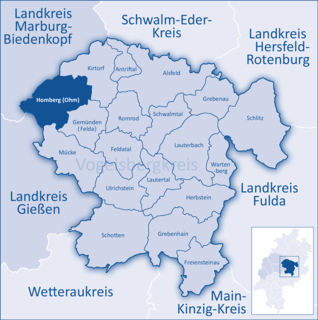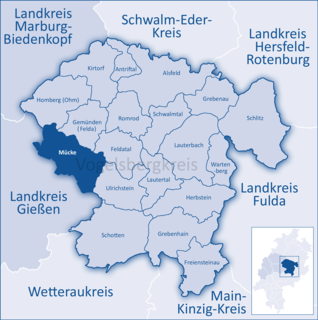
Limburg an der Lahn is the district seat of Limburg-Weilburg in Hesse, Germany.

Georg Simon Ohm was a German physicist and mathematician. As a school teacher, Ohm began his research with the new electrochemical cell, invented by Italian scientist Alessandro Volta. Using equipment of his own creation, Ohm found that there is a direct proportionality between the potential difference (voltage) applied across a conductor and the resultant electric current. This relationship is known as Ohm's law, and the ohm, the standard unit of electrical resistance, is named after him.

The Lahn is a 245.6-kilometre-long (152.6 mi), right tributary of the Rhine in Germany. Its course passes through the federal states of North Rhine-Westphalia (23.0 km), Hesse (165.6 km), and Rhineland-Palatinate (57.0 km).

The Eder[ˈeːdɐ] is a 177-kilometre (110 mi)-long major river in Germany that begins in eastern North Rhine-Westphalia and passes in to Hesse, where it empties into the River Fulda.
Ohm is a unit of electrical resistance named after Georg Ohm.

Amöneburg is a town in the Marburg-Biedenkopf district in Hesse, Germany. It lies on a mountain and is built around the castle of the same name, Burg Amöneburg.

Ebsdorfergrund is a community consisting of eleven villages in the southeast of Marburg-Biedenkopf district in Hesse, Germany.

Antrifttal is a community in the Vogelsbergkreis in Hesse, Germany.

Homberg (Ohm) is a town in the Vogelsbergkreis in Hesse, Germany.

Mücke is a community in the Vogelsbergkreis in Hesse, Germany.

Ulrichstein is a small town in the Vogelsbergkreis in Hesse, Germany.

The Dill is a 55 km (34 mi) long river, flowing through central Hesse in Germany. It is a tributary to the Lahn, joining it on the right bank at the town of Wetzlar.

Lannach is a municipality in the district of Deutschlandsberg in the Austrian state of Styria.

The West Hesse Highlands, also known as the West Hessian Lowlands and Highlands, are a heavily forested region of the Central Uplands in Germany. These highlands lie mainly within the state of Hesse, between that part of the Rhenish Massif right of the Rhine in the west, the Weser Uplands to the north, the Hessian Central Uplands to the east and the Wetterau to the south.

Elbbach is a river in Germany, about 38.1 kilometres (23.7 mi) long. It is a right tributary of the Lahn which in turn is a right tributary of the Rhine. The Elbbach starts near Westerburg in the state of Rhineland-Palatinate, and flows into the Lahn near Limburg an der Lahn in the state of Hesse. The drainage basin of this river has an area of 323.67 square kilometres (124.97 sq mi).

The Aar Dam and its reservoir, the Aartalsee, lie in the upper Aar valley in the German state of Hesse. Both are in the municipalities of Bischoffen and Hohenahr in the county of Lahn-Dill-Kreis and about 15 km northwest of the town of Gießen in Hesse. On the lakeshores lie the villages of Ahrdt and Mudersbach, both part of the parish of Hohenahr. Since 1991 the dam has impounded the River Aar, a left-hand tributary of the Dill in the Gladenbach Uplands. The reservoir is also fed by the Stadterbach, Wilsbach, Weidbach and Meerbach.

The region of Middle Hesse is one of three planning regions in the German state of Hesse, alongside North and South Hesse. Its territory is identical with that of the administrative province of Gießen and covers the counties of Limburg-Weilburg, Lahn-Dill-Kreis, Gießen, Marburg-Biedenkopf and Vogelsbergkreis. The Middle Hesse Regional Assembly, which decides on the regional plan, currently consists of 31 members chosen by the five counties and the three towns with special status: Gießen, Marburg and Wetzlar. The regional assembly has tasked the governing president (Regierungspräsident) with delivering regional management. The Mid-Hesse Regional Management Association was founded on 22 January 2003.

The Vogelsberg (help·info) is a large volcanic mountain range in the German Central Uplands in the state of Hesse, separated from the Rhön Mountains by the Fulda river valley. Emerging approximately 19 million years ago, the Vogelsberg is Central Europe's largest basalt formation, consisting of a multitude of layers that descend from their peak in ring-shaped terraces to the base.

Gabriele Hiller-Ohm is a German politician (SPD). She has been a member of the Bundestag since 2002. Since 2014, she has been the SPD parliamentary group's spokesperson for tourism policy.



















